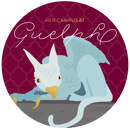Montreal novelist Heather O’Neill wrote in a 2017 article for The Walrus: “There’s the inevitable feeling that you get when you are in university that everything is actually going to work out for you. Your generation is as yet undescribed. It is a giant black art journal and you can write whatever you want in it.”
I struggled to churn out the words and sentences required to compose this article, my final wordy swan song for the Her Campus chapter at the University of Guelph, simply because there was too much to say about my four years in Guelph. Pieces that are written to conclude a period of time at university ordinarily feature distinct lessons that the writer has learned, or advice they wish to share with incoming students. But I have come to know an unquantifiable amount of truths during the completion of my bachelor of arts degree. These things cannot be distilled into a series of neat paragraphs with bolded subheadings, or strategically categorized into pieces of advice that revolve around particular themes. They collectively resemble the miscellaneous assortment of textbooks, broad mugs of steaming tea, extensive papers, plates of gnawed cookies, and colourful art projects that festooned the dented, wooden kitchen table where I completed my coursework. In short, these truths are chaotic. They are haphazardly sprinkled across my brain, like photographic snapshots strung together to form a never-ending laundry line of memories. Yet they define my time studying art history at the University of Guelph, and living in the city of Guelph. They fill the pages of my own giant black art journal that Heather O’Neill so eloquently described three years earlier.
Studying art history at the University of Guelph taught me to see. It helped me learn to fully perceive and analyze what existed, but also to scratch curiosity’s itch by analyzing what was missing or excluded from a frame, and ask why it wasn’t there. Who or what wasn’t included in the frame? And why was that the case? What did this exclusion mean? I quickly learned that research was the key to truly understanding what was being seen in a painting, photograph or sculpture. It could be an endless quest for knowledge, a labyrinth of dead ends, a process that spanned weeks or even months to find the perfect books and most importantly, peer-reviewed journal articles that were needed to compose a myriad of minor arguments that substantiated a larger and central argument. Writing was making sense of evidence, analyses, interpretations, images, and thoughts, and then there was editing and proofreading to tie the research papers and projects together. The months I spent throughout each fall and subsequent winter semester were defined by series of these rhythmic and intertwined processes. As I grew older, and completed these cycles over and over again, they grew easier. The dead ends lessened, the writing process did not take as long as it initially did, and I knew exactly what to look for as I edited my research papers. These assignments helped me to see, to question, to explore, to read, to write, to dream. They helped me comprehend how visual our contemporary world truly is, but also embodied the intriguing title of an exhibition I heard about at the MKG127 gallery in Toronto, Everything we see hides another thing. It was through the perpetual cycles of researching, writing and editing that I came to understand the importance of investigating the truths and narratives of an artwork to comprehend its context, and to attempt to perceive the stories its creator wanted to express through it.
Yet alongside my completion of coursework, I learned how to live. I learned how to replace particularly sticky, stubborn light bulbs, how to handle a leaky washer machine, how to unplug a drain with nothing but baking soda, vinegar and my bare hands. I studied the subtle arts of living with roommates, strategically shopping for healthy yet affordable food, salvaging nearly burnt spaghetti sauce and advocating for myself. While my art history degree itself taught me to see thoughtfully and intelligently, my years living in Guelph helped me jump from teenage hood to the series of mystifying realities that comprise young adulthood. Bidding farewell to this vibrant and beautiful city will inevitably and unfortunately mean saying goodbye to the people, organizations and places that I love most within it — the Arboretum, the Art Gallery of Guelph, Guelph Arts Council, Wyndham Art Supplies, The Bookshelf, Bread Bar Guelph and Miijidaa Cafe and Bistro. It is these organizations and places that formed the heart of Guelph for me. They epitomized its creative, community-based spirit that emphasized all things local.
Lastly, completing an undergrad feels a bit like preparing to unlock that giant black art journal and filling it with the stories, poems and images that offer a brief glimpse into the essence of someone’s life. Leaving Guelph means saying thousands of goodbyes, but it also means temporarily stepping away from that beautiful, hopeful attitude that Heather O’Neill articulated when she wrote, “…everything is actually going to work out for you.” This is so often associated with youth. For me, that attitude encapsulates the essence of my time at the University of Guelph. For four years I wrote, thought, studied, met the most wonderful group of friends, and learned to live. Studying art history in Guelph, and writing for Her Campus at Guelph, a club which I have come to know and love, has prepared me to leave young adulthood behind as I continue to stuff my own giant black art journal with the words and doodles of stories to come.
Farewell, Guelph.


